
The eighth annual Empty Bowls event supporting the Houston Food Bank is coming up at HCCC on May 26th, and six zealous and daring craftspeople have taken on the exciting challenge to create 100 bowls to donate towards the event.
For those of you who aren’t familiar with Empty Bowls, it is a grassroots effort led by artists across the country to feed the hungry in their communities. Hundreds of handmade bowls are donated by local artists and, in exchange for a minimum $25 cash donation, guests pick out and take home a one-of-a-kind handmade bowl as a reminder of all the empty bowls—and stomachs—in the world. Whole Foods Market will be providing a lunch of soup and bread to enjoy outside in HCCC’s Craft Garden, where there will also be live music and demonstrations.
Now back to the topic on the table, the “100 Bowl Challenge.” The challenge to make 100 bowls in 100 days was concocted by Houston artists Renee LeBlanc and Clark Kellogg. On January 3rd, the pair launched their creative, philanthropic venture with a dedicated blog. As Kellogg stated, “My goal is to turn one bowl every day for 100 days. Given the timeframe, my hope is that it forces me to think about each bowl as a sketch, rather than a finished, ‘planned’ piece.”
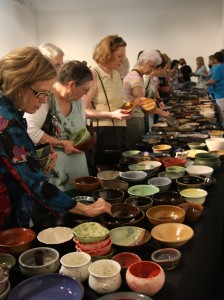

Renee LeBlanc has been working with ceramics for about three years, first at Lonestar Montgomery, and now at Glassell. She majored in art, mainly sculpture, at the University of New Orleans. When I asked to know what motivated her to take this challenge, she shared the following: “A few years ago, I was teaching at a school where over 95% of the students came from families living below the poverty level. One day, while on breakfast duty in the cafeteria, I spotted one of my kindergartners wrapping up part of her breakfast in a napkin and slipping it into her backpack. Her eyes teared up when I asked what she was doing because she knew that it was against the rules to take food out of the cafeteria. She said, ‘It’s for my baby brother. We don’t have food at home.’ This was my first real glimpse into the reality of my students’ lives. The thought of her mom and little brother waiting for her to come home from school, just so they could eat a dried up biscuit, made ME want to cry! I know that the Food Bank helped some of my other students, because I would see them boarding the bus on Friday afternoons, with a small sack of food donated by the Food Bank, to help carry them through the weekend.”
LeBlanc currently volunteers at a community medical clinic, which provides services to the “working poor.” Part of her responsibility includes reviewing income statements to determine eligibility, and she constantly thinks about the near impossibility of being able to support a family on such meager wages. LeBlanc’s motivation for taking on this challenge is the fact that she has come to know the families the food bank helps.
Angel Oloshove studied painting and drawing at the California College of the Arts and then moved to Japan and worked as a designer and commercial artist for seven years. Oloshove started making pottery after moving back to America a year ago and likes the rigor and skill involved in the ceramic-making process. She saw the 100 bowls challenge as a chance to help the local community and the Houston Food Bank. “I enjoy community building activities, and it’s good for all people, including artists, to support community charities.”
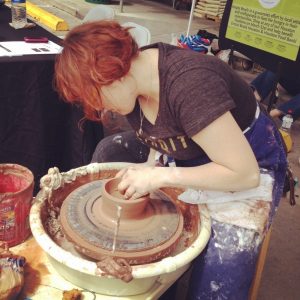
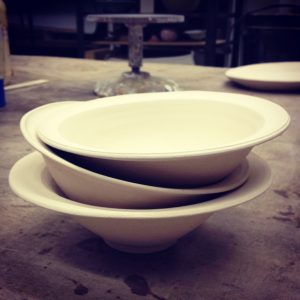
During her senior year of high school, Karen Fiscus had her first experience with the potter’s wheel, but it wasn’t until her senior year in college that she took her first real ceramic throwing class. She has had her hands in clay off and on since then and is currently in the Master of Arts program at the University of Houston-Clear Lake. As a seasoned ceramist, Karen did not face many problems producing bowls. She explains, “When I heard about the 100 Bowls in 100 Days Challenge, having done some production pottery, my thought was (not knowing it was a woodworker that started the challenge) ‘why would it take so long?’ When I started making bowls, I didn’t intend to make so many. The first week, I made 24 bowls. Two weeks later, 20 more. Then, at the UHCL Bowl-a-thon, 30 more. With a little urging from Tom Perry, making 26 more bowls didn’t seem too difficult. So, I have111 bowls finished and ready for May 26.”
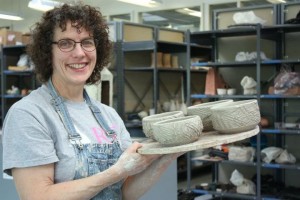
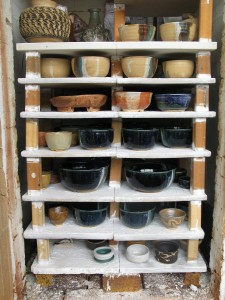
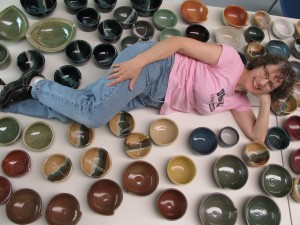
For some reason, I was most interested in hearing about the limitations and challenges the artists faced individually and how they were overcome. I mean, who doesn’t like hearing other people’s inspiring tales of redemption and completion of a project? This reminds me of a previous post I wrote about Mary Smull’s Society for the Prevention of Unfinished Needlepoints (SPUN) and the projects we often leave incomplete, despite the arduous labor initially invested. You can read here about how the staff and current artists-in-residence did not respond to my request for stories of unfinished labor, resulting in my blog post highlighting this unfinished project.
However, these craftspeople have chosen to take on this challenge and, from what I can tell, will be completing their project despite the snags. LeBlanc’s biggest challenge was the glazing process. She had a couple of incredibly disappointing moments and said she had around 40 bowls that have almost made it through the entire process, only to come out of the final step with glazes pitting, running or flaking off. On some of her favorites, she had done extensive carving, and they were fired in a kiln that contained another piece that exploded. Consequently, most of the pieces in that firing were ruined. Though it was a huge disappointment, she continued onward.
When there are hundreds of bowls sprawled out on tables, it’s easy to forget the time, energy and work that’s behind each one of these bowls. These artists obviously aren’t bowl factories, and each attempt doesn’t turn out perfectly. So, it didn’t surprise me to hear from Angel that the biggest challenge she faced was attempting to produce a large amount of work without sacrificing quality or design. She stated, “I wanted each bowl to be a unique entity and to be given the right amount of care. I engage in a craft-based process to celebrate the handmade.”
With that in mind, we hope you will join us on May 26th by purchasing one of the hundreds of handmade bowls that will be available in this effort to help those less fortunate in our community. And, perhaps, this will be the first of many 100 Bowl Challenges for years to come!
–Ashley Powell, HCCC Curatorial Assistant

